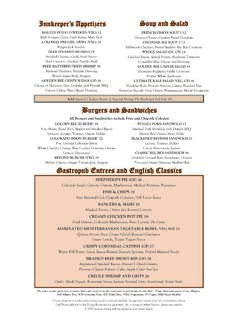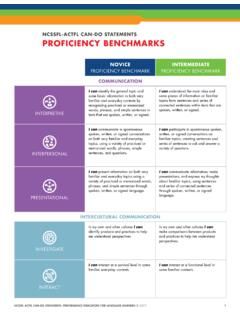Transcription of French, German and Spanish
1 french , German and Spanish GCSE subject content January 2022. Contents The content for french , German and Spanish GCSEs 3. Introduction 3. Subject aims 3. Subject content 4. Composition of vocabulary content 6. Grammar content 7. Annexes 10. Annex A: french grammar and sound-symbol correspondences (foundation and higher tier) 10. Annex B: German grammar and sound-symbol correspondences (foundation and higher tier) 20. Annex C: Spanish grammar and sound-symbol correspondences (foundation and higher tier) 29. Annex D: Families of regular inflected words for each language 38. Annex E: Required and optional vocabulary which the grammar annexes require for each of french , German , and Spanish . 40. 2. The content for french , German and Spanish GCSEs Introduction 1. This document sets out the learning outcomes and content coverage required for GCSE specifications in french , German and Spanish .
2 The GCSE subject content sets out the knowledge, understanding and skills common to all GCSE. specifications in a given subject. Together with the assessment objectives, it provides the framework within which the awarding organisations create the detail of their specifications, so ensuring progression from key stage 3 national curriculum requirements and the possibilities for development into A Level. 2. GCSE specifications in french , German and Spanish will take account of the national curriculum programmes of study for key stages 2 and 3. They will build on the foundations of grammar, vocabulary and linguistic competence envisaged by the programmes of study for key stages 2 and 3, increasing the level of linguistic and cognitive demand. 3. Linguistic content for GCSE in french , German and Spanish will focus largely but not exclusively on the most commonly occurring vocabulary of each language.
3 Vocabulary and grammatical requirements for each tier will be clearly defined in the specification. Students will be expected to know and use the linguistic content specified receptively and productively, in the oral and written modalities, with an approximately equal emphasis on each. Subject aims 4. GCSE specifications in french , German and Spanish should provide a coherent, satisfying and worthwhile course of study. They should encourage students to develop confidence in, and a positive attitude towards, french , German and Spanish and to recognise the importance of languages. They should also provide a strong linguistic and cultural foundation for students who go on to study languages at a higher level post-16. 5. Through studying a GCSE in a modern foreign language, students should develop their ability and ambition to communicate independently in speech and writing with speakers of the language for authentic purposes and about subjects which are meaningful and interesting to them.
4 The study of a modern foreign language at GCSE should also build students' confidence and broaden their horizons, enabling them to step beyond familiar cultural boundaries, develop new ways of seeing the world, and better understand relationships between the foreign language and the English language. 6. It is important that students following a GCSE course should become familiar with aspects of the contexts and cultures of the countries and communities where the language is spoken. Linguistic content may be developed through a range of broad themes and topics which have, for example, cultural, geographical, political, contemporary, historical or employment-related relevance. Linguistic content which is largely, though not exclusively, determined by frequency will enable material 3. relating to most broad themes and topics to be used, and will unlock a wide range of spoken and written texts.
5 Subject content 7. GCSE specifications in french , German and Spanish should enable students to: a. Learn and use the range of vocabulary required for the level at which they are studying. The parameters for specifying the vocabulary to be learnt are set out in paragraphs 13-21 of this document. b. Learn and use the grammar specified to understand and produce meaning in written and oral modalities. The grammar to be learnt in each language is set out in Annexes 1-3 of this document. c. Learn and apply the principles by which spelling represents sounds in standard or widely used forms of the language, and use clear and comprehensible pronunciation when speaking the language. 8. Students should be able to use the language they are learning both receptively and productively, in spoken and written forms, for a range of audiences and purposes, in different genres and in formal and informal contexts which are relevant to their current and future needs and interests, having regard to the likely experiences of a wide social range.
6 They should be able to recall and use language in different situations and be able to move between the language they are learning and English. 9. GCSE specifications in french , German and Spanish must require students to: a. understand written texts in the language. Texts will predominantly focus on the defined vocabulary and grammar for each tier and will be of limited complexity at foundation tier. b. understand spoken extracts comprising the defined vocabulary and grammar for each tier which are delivered at a pace which is no faster than a moderate pace, where each word is clearly discernible (as appropriate to pronunciation norms for each language), and which do not contain extraneous distractions or interruptions;. c. Undertake dictation of short, spoken extracts (including some vocabulary from outside the vocabulary list) with credit for accurate spelling. d. write text in the language in a lexically and grammatically accurate way in response to simple and familiar stimuli.
7 E. translate in writing short sentences or texts, from the language to English and vice versa, using a range of the vocabulary and grammar specified for each tier. In this context, translation means an appropriate and sufficient rendering of the meaning of the original language. 4. f. infer, by using knowledge of the vocabulary and grammar specified for each tier, plausible meanings of single words from outside the Vocabulary List when they are embedded in the context of written sentences. g. speak using clear and comprehensible language to: i. read aloud a short written text and undertake a short unprepared conversation relating to the text;. ii. undertake role play(s), including asking and answering questions, simulating a context such as a social conversation, where instructions about what to say are unambiguous;. iii. talk about one or more visual stimulus/stimuli, such as (connected).
8 Photographs or pictures, and extend this conversation into a short unprepared interaction. Pupils should have suitable specified preparation time for each of the above components without access to reference materials. For spoken and written production, the expected language will be from the defined content (vocabulary, grammar, and sounds) for each tier, with equal credit given for language used that is beyond the defined content but that fulfils the task requirements. 10. Complexity1 of language: Spoken and written language (for comprehension and production) will be of limited complexity at foundation tier. At higher tier students will be expected to understand (in listening and reading) and produce (in speech and writing) language at a higher level of complexity. The complexity of the language will be in both cases appropriate to the level of study. 11. Question types: Where questions are designed to test comprehension of written and spoken texts in the assessed language, these comprehension questions will be in English.
9 Other types of question may be in English or the assessed language as appropriate to the task. Rubrics will be in English. 12. Themes and topics: Because most, though not all, vocabulary, defined in specifications is informed by the frequency of occurrence in the language, it will enable access to a wide range of themes and topics. Specifications should identify a limited number of broad themes or topics with relevance to the countries or communities where the language is spoken. These could cover, for example, cultural, geographical, political, contemporary, historical or employment-related aspects, as appropriate to the themes and level of learning. These themes and topics are not intended to be specifically reflected in texts selected for terminal 1. Complexity in this sense means the extent to which a text uses features such as multi-clause units ( , relative clauses), pronouns, especially multiple pronouns, multiple verbs in one sentence or clause , long sentences, or morphology and syntax ( , word order) which is very different to English in form and/or function.
10 5. assessment. To illustrate the themes and topics set out, specifications may identify some vocabulary (drawn from the defined list) which may be relevant to each. Composition of vocabulary content 13. Students will be expected to know 1,200 lexical items for foundation tier, and a further 500 lexical items for higher tier. Students will also be required to know words which can be regularly inflected and (for reading only) regularly derived from listed lexical items using the grammar specified in the grammar annex (exemplification at Annex D). Because no vocabulary is specified for KS2 or KS3, the Vocabulary List proposed for GCSE must be comprehensive and should make no assumptions about vocabulary previously taught. 14. Vocabulary lists must include, as part of the 1,200 or 1,700 items, the words listed at Annex E. These are the words which are referenced in the grammar annex for each language and so need to be included.














